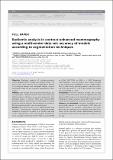Files in this item
Radiomic analysis in contrast-enhanced mammography using a multi-vendor data set : accuracy of models according to segmentation techniques
Item metadata
| dc.contributor.author | Savaridas, Sarah | |
| dc.contributor.author | Agrawal, Utkarsh | |
| dc.contributor.author | Fagbamigbe, Adeniyi | |
| dc.contributor.author | Tennant, Sarah L | |
| dc.contributor.author | McCowan, Colin | |
| dc.date.accessioned | 2023-05-15T10:30:03Z | |
| dc.date.available | 2023-05-15T10:30:03Z | |
| dc.date.issued | 2023-04-01 | |
| dc.identifier | 283587823 | |
| dc.identifier | af5f1301-e049-44ee-9c9c-1d6c63d74e68 | |
| dc.identifier | 85153544557 | |
| dc.identifier.citation | Savaridas , S , Agrawal , U , Fagbamigbe , A , Tennant , S L & McCowan , C 2023 , ' Radiomic analysis in contrast-enhanced mammography using a multi-vendor data set : accuracy of models according to segmentation techniques ' , The British Journal of Radiology , vol. 96 , no. 1145 , 20220980 . https://doi.org/10.1259/bjr.20220980 | en |
| dc.identifier.issn | 0007-1285 | |
| dc.identifier.other | RIS: urn:131452B2F982197A6984271AD9A1B1B0 | |
| dc.identifier.other | ORCID: /0000-0002-9466-833X/work/130203721 | |
| dc.identifier.uri | https://hdl.handle.net/10023/27613 | |
| dc.description | Funding: British Society of Breast Radiology grant, TENOVUS Scotland. | en |
| dc.description.abstract | Objective Radiomic analysis of contrast enhanced mammographic (CEM) images is an emerging field. The aims of this study were to build classification models to distinguish benign and malignant lesions using a multi vendor dataset and compare segmentation techniques. Methods CEM images were acquired using Hologic and GE equipment. Textural features were extracted using MaZda analysis software. Lesions were segmented with freehand region of interest (ROI) and ellipsoid_ROI. Benign/Malignant classification models were built using extracted textural features. Subset analysis according to ROI and mammographic view was performed. Results 269 enhancing mass lesions (238 patients) were included. Oversampling mitigated benign/malignant imbalance. Diagnostic accuracy of all models was high (>0.9). Segmentation with ellipsoid_ROI produced a more accurate model than with FH_ROI, accuracy:0.947 vs 0.914, AUC:0.974 vs 0.86, p < 0.05. Regarding mammographic view all models were highly accurate (0.947–0.955) with no difference in AUC (0.985–0.987). The CC-view model had the greatest specificity:0.962, the MLO-view and CC + MLO view models had higher sensitivity:0.954, p < 0.05. Conclusions Accurate radiomics models can be built using a real-life multivendor dataset segmentation with ellipsoid-ROI produces the highest level of accuracy. The marginal increase in accuracy using both mammographic views, may not justify the increased workload. Advances in knowledge Radiomic modelling can be successfully applied to a multivendor CEM dataset, ellipsoid_ROI is an accurate segmentation technique and it may be unnecessary to segment both CEM views. These results will help further developments aimed at producing a widely accessible radiomics model for clinical use. | |
| dc.format.extent | 8 | |
| dc.format.extent | 597105 | |
| dc.language.iso | eng | |
| dc.relation.ispartof | The British Journal of Radiology | en |
| dc.subject | Contrast-enhanced mammography | en |
| dc.subject | Mammography | en |
| dc.subject | Radiomics | en |
| dc.subject | Breast cancer | en |
| dc.subject | RC0254 Neoplasms. Tumors. Oncology (including Cancer) | en |
| dc.subject | E-NDAS | en |
| dc.subject | SDG 3 - Good Health and Well-being | en |
| dc.subject | MCC | en |
| dc.subject.lcc | RC0254 | en |
| dc.title | Radiomic analysis in contrast-enhanced mammography using a multi-vendor data set : accuracy of models according to segmentation techniques | en |
| dc.type | Journal article | en |
| dc.contributor.institution | University of St Andrews. School of Medicine | en |
| dc.contributor.institution | University of St Andrews. Population and Behavioural Science Division | en |
| dc.contributor.institution | University of St Andrews. Sir James Mackenzie Institute for Early Diagnosis | en |
| dc.identifier.doi | https://doi.org/10.1259/bjr.20220980 | |
| dc.description.status | Peer reviewed | en |
This item appears in the following Collection(s)
Items in the St Andrews Research Repository are protected by copyright, with all rights reserved, unless otherwise indicated.

